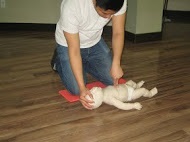
Picture this: you have gone to attend Thanksgiving at your friend’s home, and as you are busy making preparations, one of you admits that they are not feeling too well, and they are experiencing slight dizziness. All of you simply ask that she takes a rest, only for you to turn and discover that they passed out cold, yet they had not taken any drinks. What would your first reaction be? Sad as it sounds, this scenario is actually replicated in many homes worldwide, only that it happens to different people, both young and old. The sadder bit of it all, is that when it comes to life and death, there is a very thin and fine line. This is one of the reasons why it is important to learn the techniques required to give adult, child and infant CPR and First aid care.
Grim statistics today show that the typical response of an ambulance takes anywhere between 5 and 15 minutes (subject to many variables such as the location where you live, traffic, time it takes for the rescuer to call for ambulance services among many other factors). The wakeup call among all this is the fact that it takes just about four minutes for the brain to undergo irreversible damage. It is clear that the time disparity is more than enough reason for individuals to take up the initiative and learn adult, child and infant CPR.
[youtube url=”https://www.youtube.com/watch?v=ajyGBvfNuxU” width=”220″]Not only can this save lives, it can also prevent irreversible damage from occurring, something that presents a perfect gift to your friends and loved ones should the need ever arise. What better gift to give than to save a life? Having understood the importance of CPR, it is critical to ensure that you understand the differences between adult, child and infant CPR. Even before looking at the differences between the types of CPR, you may want to look at the similarities that abound. The first similarity and the most obvious, is the fact that the different techniques used are carried out with the aim of ensuring that blood supply is not cut off from the vital organs of the body. Listed below are the differences between adult, child and infant CPR.
Owing to the remarkable differences in the anatomy and physiology of an infant, a child and an adult, it becomes imperative to alter the procedure of CPR techniques. The first key difference arises from the ideal time to call 911 if you are the only person available with the victim. For adults, it is advisable to call 911 before proceeding to carry out CPR. In children and infants, it is recommended that you start off CPR immediately before calling 911. The reason for this is that children have more resilience than adults, and are better placed to go through recovery. When giving rescue breaths in infants and children, ensure that you do not tilt the head too far as you would in an adult, and this is to prevent injuries. Overall, the training required for adult, child and infant CPR is a lifesaver.
